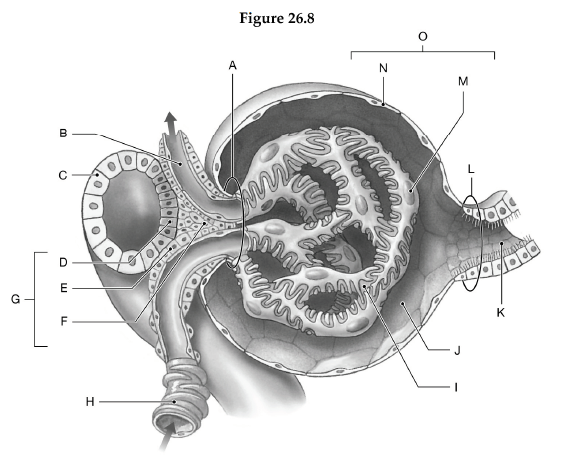Using the figure below, identify the labeled part.

1) Label A: ______________________________
2) Label B: ______________________________
3) Label C: ______________________________
4) Label D: ______________________________
5) Label E: ______________________________
6) Label F: ______________________________
7) Label G: ______________________________
8) Label H: ______________________________
9) Label I: ______________________________
10) Label J: ______________________________
11) Label K: ______________________________
12) Label L: ______________________________
13) Label M: ______________________________
14) Label N: ______________________________
15) Label O: ______________________________
1) Vascular pole
2) Efferent arteriole
3) Distal convoluted tubule
4) Macula densa
5) Juxtaglomerular cells
6) Extraglomerular mesangial cells
7) Juxtaglomerular complex
8) Afferent arteriole
9) Glomerular capillary
10) Capsular space
11) Proximal convoluted tubule
12) Tubular pole
13) Visceral epithelium (podocyte
14) Parietal epithelium
15) Glomerular capsule
You might also like to view...
When the testes are exposed to cool temperatures,
A. the scrotal septum opens, allowing the testes to share warmth. B. the dartos and cremaster muscles contract to bring the testes closer to the body. C. testosterone production stops. D. there is an increase in sperm production. E. None of the choices is correct; the testes are not affected by temperature.
Exocytosis occurs as a result of
A. hydrostatic pressure. B. the expenditure of energy in the form of ATP. C. molecular movement with carrier assistance. D. concentration gradients. E. ion pumps.
The visual cortex is located in the _______ lobe.
A. Frontal B. Occipital C. Temporal D. Parietal E. Insula
All of the following cells are considered "footloose," as they lack cellular junctions, EXCEPT __________.
A)phagocytic cells B)blood cells C)sperm cells D)epithelial cells